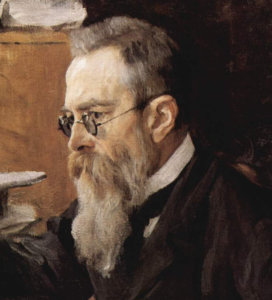Rimsky-Korsakov, Capriccio Espagnol
You may have thought that only French composers could write Spanish music, but here’s proof that Russians can do it too. Okay, that’s a bit overstated: we could find plenty of superb Spanish composers. But it’s hard not to think of Bizet’s Carmen, Ravel’s Rhapsodie Espagnole, and Rimsky-Korsakov’s Capriccio Espagnol when the subject of Spanish music comes up.
It seems quite natural that composers from various European countries would be drawn to the color and richness of Spanish music. Spain’s unique history within Europe gives it an exotic flavor. Nine centuries of Muslim influence leave their mark.
 And if it’s orchestral color that is needed to convey this exoticism, Rimsky-Korsakov was just the guy to do it. From his earliest forays into composition, Rimsky-Korsakov showed a particular talent for orchestration. (He was trained not as a musician, but to be a naval officer.) While still in his teens, he became friends with Mussorgsky, Cui, and Balakirev, who encouraged his musical development. With Borodin, they would later comprise the “Mighty Five.”
And if it’s orchestral color that is needed to convey this exoticism, Rimsky-Korsakov was just the guy to do it. From his earliest forays into composition, Rimsky-Korsakov showed a particular talent for orchestration. (He was trained not as a musician, but to be a naval officer.) While still in his teens, he became friends with Mussorgsky, Cui, and Balakirev, who encouraged his musical development. With Borodin, they would later comprise the “Mighty Five.”
After completion of his naval service obligations, Rimsky-Korsakov landed the job of Inspector of Naval Bands, which paid him well and left ample time for composition. He focused on opera. And for a time in 1871-1872, he shared a flat with Mussorgsky. The two took turns working at the same piano, Rimsky-Korsakov composing The Maid of Pskov and Mussorgsky Boris Gudonov.
Capriccio Espagnol was composed in 1887. It is often described as a masterpiece of orchestration, but Rimsky-Korsakov disagreed. He described it as a study in virtuoso orchestration in which the brilliant instrumental coloring is “the very essence of the composition, not its mere dressing-up.” This work would lead, in a year, to Rimsky-Korsakov’s other two great symphonic suites: Scheherazade and Russian Easter Festival.
Rimsky-Korsakov worked periodically throughout his life to create a treatise on orchestration. It was left unfinished at his death, but was completed by his son-in-law in 1912 and published in 1922. It remains one of the primary authorities on the topic.



